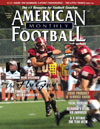AMERICAN FOOTBALL MONTHLY THE #1 RESOURCE FOR FOOTBALL COACHES
Article CategoriesAFM Magazine
|
Myths vs. Facts - The A-11 Offense a Year Laterby: Mike KucharSenior Writer, American Football Monthly © More from this issue It was only last spring when AFM first debuted this radical new offensive scheme that was conceived in the living room of Steve Humphries, the offensive coordinator at Piedmont High School in California. Back then it might have only been a fad when Humphries and head coach Kurt Bryan had just installed it the season before and really had only implemented it on offense around 70 percent of their snaps. But since, it has taken on a life of its own. Like any fad that starts to pick up speed, the A-11 has become more of a trend, particularly in the California Bay area, and may be coming to a program near you. The scheme has been featured in The Washington Post, made four appearances in The New York Times and has been mentioned among the “Top 10 innovative football ideas” in ESPN The Magazine. Its DVD sales are among the highest....The full article can only be seen by subscribers. Subscribe today!
|
|
|||||||
| HOME |
MAGAZINE |
SUBSCRIBE | ONLINE COLUMNISTS | COACHING VIDEOS |
Copyright 2025, AmericanFootballMonthly.com
All Rights Reserved





